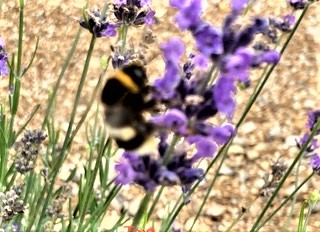The Humble Bumble (first published in West Sussex County Times)
 When I was invited to write an article on my experience with bumble bees, this title came to mind. I like to think it’s part of Christopher Bollas’s ‘unthought known’ territory – something you’ve carried around in your mind without ever really realising it. And as it turns out, the phrase is rather apt: Darwin referred to them as the ‘hum bee’ – because they ‘hummed’.
When I was invited to write an article on my experience with bumble bees, this title came to mind. I like to think it’s part of Christopher Bollas’s ‘unthought known’ territory – something you’ve carried around in your mind without ever really realising it. And as it turns out, the phrase is rather apt: Darwin referred to them as the ‘hum bee’ – because they ‘hummed’.
I came to Britain from the U.S. over twenty years ago and discovered its deep passion for gardens. I soon wanted my own, filled with butterflies, as I’d seen in most garden photos. It all changed one day as I was sitting admiring my tall blue butterfly-friendly delphiniums at the back of the very small plot sloping down to a hedge, I noticed one or two large bumblebees flying to the delphiniums and I found myself wondering how on earth they could fly, something I’d never thought much about – these fat little balls with short wings. Nature in defiance or defiance in nature? How could you not be taken with that?
Over time, I learned that these purposeful, inquisitive beings were attracted to blue and purple flowers, but not red and they only visited white or yellow if they were next to blue or purple.
Other intriguing facts:
- Bumblebees feed on nectar and gather pollen, but they don’t make honey; only the honeybees do this. The nectar provides energy for flying and pollen provides protein for the nest’s bee grubs.
- Male bumblebees, having left the nest, do not return. Only the females return, and it is only the females that gather pollen which you can see in sacks on the backs of their legs. Males do not have these sacks.
- You rarely see bumbles in rose gardens because, colour aside, the dense petals prevent them from reaching the nectar and pollen.
- When not mating, the males spend their time at the bee pub – i.e., enjoying the nectar! But to their credit, they are a gentle lot as the males don’t have stingers.
I now have a very small wildflower meadow where my humble bumbles flourish along with butterflies. These beautiful gifts from nature need us, but it is we who need them so much more.
By Alice Owens

Sussex Green Living notes that without insects to pollinate our food, our own species would have a job surviving. Why not plant bee friendly flowers and put up a few bee nest boxes? They will need careful siting – sunny with dappled shade ideally. There are many websites to help you build your own attractive bee or insect houses quite easily with recycled natural materials.
A wonderfully inspiring film about our food security called, ‘Seeds of Vandana Shiva’ will be shown on October 5th as part of the Horsham Green Film Festival. You can reserve your ‘Pay-what-you-feel’ ticket HERE. There will also be a Seed Swap event on the night, so start collecting your seeds now to bring along and share. Simply name the envelope with the plant, so it’s not a lucky dip!



